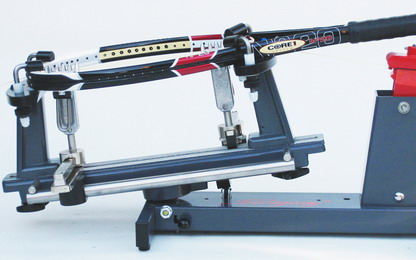Thanks for discussing my opinion. I'm learning the princple of stringing machine from beginning. If it's wrong i'll fix it.
I just thought it should be constant tension to pull the string from this paper:
"Strings need between 3 and 10 seconds time to stretch when they are tensioned. A constant pull tension unit keeps the tension in the string constant during this elongation of the string.A nonconstant pull tensioner looses tension depending on the type of string and on the speed of pulling"
http://www.stringforum.net/nl/download/The_Importance_Of_Constant_Pull.pdf
So to avoid the string elongation, it should be constant pull with constant tension.
I think the string's elongation property maybe different for different tension, and different speed eg.length of the pulling time.
According to the "speed of pulling", if a crank pulling slowly enough then it is most like constant pull with constant tension. For example 60lbs is the correct tension, pulling slowly, when the header arrive at 58lbs, pulling more slowly to the end. Such as some electronic machine's speed adjustment. But not like electronic machine, crank do that depend on the stringer's experience.
For manual machine, crank or dropweight, only stringway call its constant pull with constant tension.
I don't know how does it do that. Most dropweight's tension is depend on the angle according to the f = (M g / r) (cos Q) R in lethalfang's topic. It must has some additional function to do that.
"The string is tensioned at the right tension now (independent of the angle of the drop weight lever)."
Accordint to this pic, when the crank locked, but the spring is still working(If the crank's princple is same as i painted, tension head locked, but not locked both side of the spring, and the spring is a "Compression Spring"). I think it is still pulling too. Crank is continually pulling by the spring, as the continually pulling by gravity in dropweight.
But both are not pulling at the correct tension according to the string elongation. It's easy to notice this by the indicator in dropweight, but not easy to find this in crank, because the indicator is still at the correct tension number. When the string elongating, the spring is loosing, the lever is droping. We can caculate the current tension by angle "a" or angle "b". Sorry,long time didn't do caculating job, can't write a accurate formula as lethalfang's. If the angle "a" is -90, tension is 0 in dropweight. If the spring loose to the max, it's 0 too. So we have to both adjust the angle in the dropweight, and repull in the crank.
In this case, the string elongating speed is always slower than the speed of gravity or spring returning to 0 tension. otherwise, gravity or spring didn't pulling the string. If I said dropweight is not continuously pull in previous opinion, it's my mistake, didn't notice the speed is different.
We have to adjust the lever if it is not at the horizon position whether pulling slowly or not, because the angle between the lever and the gripper is constant, that mean the string length can't be changed automaticly. But if a crank pulling slowly, maybe don't need to release and pull again, the string length can be changed when the tension head moving on the rack. But pulling speed control need a good skilled stringer's experience.
If the stringer can't wait the elongation time(2-3seconds in that paper) or experience is not enough to control the pulling speed as what the electronic machine do. Then using Pre-Stretch is better. Maybe most stringer using this method, all electronic machine provide this function. And I think the speed control on electronic machine is same as the constant pull with constant tension function.
'Ray_cn' you have so many bad assumptions in your post I don't know where to start. Let me just comment on constant pull. Any machine that continues to pull tension is constant pull. Let's take a lockout. It pulls until it locks out then stops so it is not constant pull. Any drop weight that uses gravity to pull is constant pull unless gravity stops pulling for some reason. It make not always pull at a constant tension but drop weights are always pulling. Don't assume constant pull is constant tension.
For a stringing machine to have 360 rotation you need to pull from below the stringbed. You can do that by either tilting the racket or placing the tensioner below the stringbed. There are other ways of doing it but things start getting in the way.






